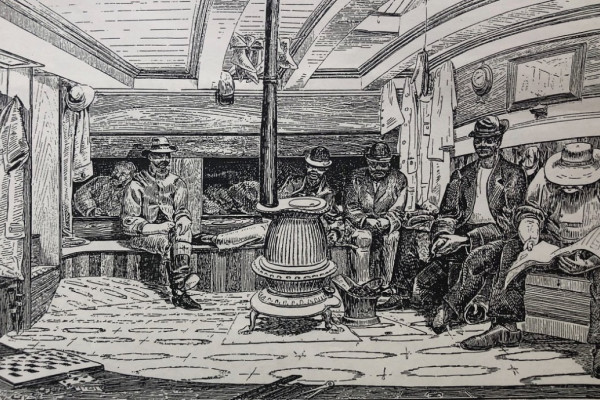
Mackerel fishermen enjoy downtime. From “The Fisheries and Fishery Industries of the United States,” G.B. Goode, 1887
By Seth Rolbein
Picture this:
Dozens upon dozens of boats moving in and out of Cape Cod harbors, all under sail, employing thousands of men, all with the same mission:
Catch mackerel.
So it was in the mid-1800s, when mackerel was king and Cape Cod fishermen led not just the state but the nation in bringing them home. Indeed it’s fair to say that mackerel, more than codfishing or whaling, created what was probably the most prosperous era in Cape Cod history.
Here are some figures that offer a sense of scale, and growth of an historic fishery.
In 1802, the town of Wellfleet boasted 25 fishing vessels; five were whalers, four were going for cod and/or mackerel, four were for oystermen, and 12 were classified as “small local,” meaning they hugged closed to shore and caught what came around.
Fast forward to 1851, 50 years:
Wellfleet alone was home to 79 vessels targeting mackerel. Those vessels employed 832 crew, an amazing percentage of the entire town of 2400 residents. Only Gloucester had more vessels at port than Wellfleet, but now add the other active Cape towns: Provincetown had 61 mackerel boats, Truro 52, Harwich 48, Dennis 37, Barnstable 28, Chatham 19. Taken together, they far outpaced Gloucester, and anywhere else.
Landings reported by the state at that time reflect the amazing effort:
1850-51 was the second highest volume landed through the heydays of the early and mid-1800s, 330,000 barrels of mackerel brought home. A standard barrel was about 40 gallons; 13.2 million gallons of one type of fish.
What’s more, these boats jigged, meaning men and boys perched over the side of the schooner or sloop, hook and line in hand, and pulled or gaffed fish out of the water one by one. It was at this time that seine boats began to show up, open vessels as long as 40 feet, towed behind the main fishing boat until ready to work, playing out broad nets that circled and captured whole schools. It took many years, but it’s likely that the purse-seine innovation was in part responsible for eventually diminishing the stocks. When you jig, you’re only catching fish that want to bite a hook, but when you seine, most every fish in the school is going to get caught.
One of the Cape’s great 20th century characters, George Bryant from Provincetown, was a dedicated amateur historian among many things. He liked to set records straight, correct misimpressions, and give credit where it was due – whenever he wasn’t collecting and lugging anything not bolted down to his yard (which was the former home of the famous Arctic explorer Admiral Donald MacMillan). Mackerel was one of George’s many favorite topics, in part because the fish’s importance had been ignored or overlooked.
“When you look at the 19th century homes and institutions … you have to think of mackerel,” Bryant told the Wellfleet Historical Society in a speech in 2001:
“Mackereling was distinctive in a number of ways. It tended to be very risky. Very good years could be followed by several dismal ones and visa versa. An owner who was heavily invested in vessels and equipment could lose everything financially in series of bad years … It tended to be a ‘commuters’ fishery as the mackerel vessels often tied up in ports at night and usually docked on Sundays when the men would try to head for home.”
Not to naysay George, but the mackerel fishery also took off for long journeys, often into Canadian waters up by the Gulf of St. Lawrence where they spawn in early summer, or Prince Edward Island. Trips could last four weeks or even twice that long, resulting in hundreds of barrels arriving at once. Depending on quality, the fish could sell for anywhere from $4 to $10 a barrel, so there was real money to be made. Then again, inshore mackerel caught by smaller boats as well as weirs planted along the coast also could pull in big volume depending on the year.
Mackereling usually started in mid-May, done by November. As far back as 1671, it was mentioned in a Colonial code of law as an important fish that needed to be regulated and sustained. And it was, all the way into the era of engines replacing sail, nets replacing hooks, factory trawlers hauling massive weight. Even into the 1880s Massachusetts was landing more than 250,000 barrels of mackerel a year, down from the heydays but still a huge amount. As a single mackerel can spawn a million or more eggs in a batch, with five or more batches a season, the natural opportunity to replenish is strong.
These days fishery managers are trying to rebuild mackerel stocks, and major effort to push large “mid-water” trawlers farther off the coast should help. Annual fleet-wide mackerel catch limits hover around 20,000 metric tons, still an amazing amount though scientists say holding at that level would allow the fish to rebuild over five years or so. Local fishermen don’t catch anywhere near that volume, but do sometimes turn their attention to mackerel, often in the fall.
Even if this oversight works, we will never again see days when mackerel ruled as they did 150 years ago. Small as they are, they were economically powerful, in that way much like the fish they are closely related to, and closely resemble though drastically miniaturized; giant tuna.
(For more great illustrations of the 1800s mackerel fishery, check out this photo gallery)
